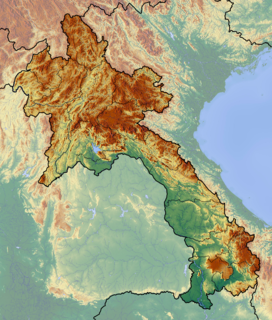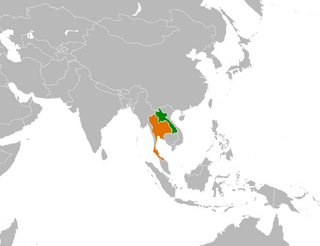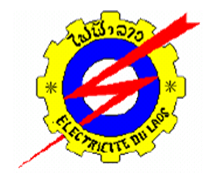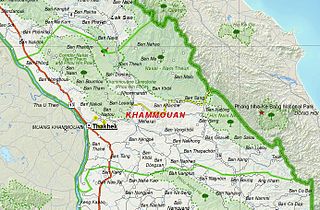
The economy of Laos is a rapidly growing lower-middle income developing economy. Being one of five remaining socialist states, the Lao economic model resembles the Chinese socialist market and/or Vietnamese socialist-oriented market economies by combining high degrees of state ownership with an openness to foreign direct investment and private ownership in a predominantely market-based framework.

Dams and reservoirs in Laos are the cornerstone of the Lao government's goal of becoming the "battery of Asia".

The Nam Theun 2 Hydropower Project, or simply NT2, is a hydroelectric dam on the Nam Theun River in Laos. Commercial operation of the plant began in April 2010. The scheme diverts water from the Nam Theun, a tributary of the Mekong River, to the Xe Bang Fai River, enabling a generation capacity of 1,075 MW, from a 350 m (1,148 ft) difference in elevation between the reservoir and the power station.

The Nam Ngum Dam is a hydroelectric dam on the Nam Ngum River, a major tributary of the Mekong River in Laos. It was the first hydropower dam built in the Lao PDR.

Energy in Thailand refers to the production, storage, import and export, and use of energy in the Southeast Asian nation of Thailand. Thailand's energy resources are modest and being depleted. The nation imports most of its oil and significant quantities of natural gas and coal. Its energy consumption has grown at an average rate of 3.3% from 2007–2017. Energy from renewables has only recently begun to contribute significant energy.

Laos and Thailand have had bilateral relations since the time of their precursor Lan Xang and Ayutthaya kingdoms in the 15th century. The two countries share a border and express linguistic and cultural similarities. The Lao kingdom of Lan Xang included all of northeastern Thailand as recently as the early 18th century. Thailand's northeastern region, Isan, has particularly strong Lao roots. Linguistically, the inhabitants of Isan, a third of the Thai population, speak the Isan language, a Lao dialect. Diplomacy has concentrated on the Mekong River, seeking to make it a "river of true peace and friendship", as made explicit in statements by both respective prime ministers in 1976.

Électricité du Laos(EDL) is the state corporation of Laos that owns and operates the country's electricity generation, electricity transmission and electricity distribution assets. The company also manages the import and export of electricity from the national electricity grid of the country. EDL was founded in 1959 and is headquartered in Vientiane.
Lao Holding State Enterprise(LHSE) is a state corporation of Laos that is primarily involved with the financing of the energy industry, including the Nam Theun 2 Power Company, of whose stock it controls 25%. LHSE is involved with other projects of Laos' energy infrastructure, including Nam Ngum Dam, Nam Ngiep Dam and the Hongsa Lignite Power Plant. The company is part of the Ministry of Finance.
Tractebel is an international company, with Belgian roots, providing worldwide life-cycle consultancy and engineering in power, nuclear, gas, industry and infrastructure for the GDF SUEZ Group – within GDF SUEZ Energy Services – as well as for national and international institutions and customers in public or private markets.

The estimated hydropower potential of the lower Mekong Basin is 30,000 MW, while that of the upper Mekong Basin is 28,930 MW. In the lower Mekong, more than 3,235 MW has been realized via facilities built largely over the past ten years, while projects under construction will represent an additional 3,209 MW. An additional 134 projects are planned for the lower Mekong, which will maximize the river's hydropower generating capacity. The single most significant impact—both now and in the future—on the use of water and its management in the Mekong Region is hydropower.

NTPC Limited, formerly known as National Thermal Power Corporation Limited, is an Indian Public Sector Undertaking, engaged in the business of generation of electricity and allied activities. It is a company incorporated under the Companies Act 1956 and is promoted by the Government of India. The headquarters of the company is situated at New Delhi. NTPC's core business is the generation and sale of electricity to state-owned power distribution companies and State Electricity Boards in India. The company also undertakes consultancy and turnkey project contracts that involve engineering, project management, construction management, and operation and management of power plants.

The Houay Ho is a dam located in the Samakkhixay District of Attapeu Province, Laos, 160 km (99 mi) east of Pakse and 30 km (19 mi) northwest of Attapeu. The project is considered the first privately financed joint venture 'build-operate-transfer' (BOT) hydropower project in Laos. It has installed capacity of 152.1 megawatts (204,000 hp), almost all of which is exported to Thailand.

Simhadri Super Thermal Power Plant is a coal-fired power plant located in the outskirts of Visakhapatnam city in the Indian state of Andhra Pradesh. The power plant is one of the coal fired power plants of NTPC, a Government of India enterprise. The coal for the power plant is sourced from Kalinga Block of Talcher Coal fields in Odisha. The plant is a national asset, and power generated is shared between multiple states, as the operator is national. Power generated by units 1 and 2, making up for 1,000 MW, is dedicated to power distribution companies owned by the Government of Andhra Pradesh and Telengana. The remaining 1,000 MW, generated by units 3 and 4, is allocated to the states of Odisha, Tamil Nadu, Karnataka, A. P., Telangana and pondicherry as per their shares as decided in PPA.
This page describes energy and electricity production, consumption and import in Laos.

Bolikhamsai is a province of Laos. Pakxanh, Thaphabath, Pakkading, Borikhan, Viengthong and Khamkheu are its districts and Paksan is its capital city. The province is the site of the Nam Theun 2 Dam, the country's largest hydroelectric project.

Khammouane Province (Khammouan) is a province in the center of Laos. Its capital lies at Thakhek.

Xaisomboun is a mountainous province in Central Laos, between Vientiane Province and Xiangkhouang Province. The province covers an area of 8,300 square kilometres (3,200 sq mi) and had a population of 85,168 in 2015. Xaysomboun town in Anouvong District is the economic centre. There are extensive copper and gold mining operations nearby at Sana Somboun.

The Nam Ou cascade hydropower project is a series of seven hydroelectric dams along the Nam Ou river managed by the Power Construction Corporation of China (PowerChina) and the Lao government. The project is located in the provinces of Phongsaly and Luang Prabang in northern Laos. The series of dams include seven levels of reservoirs in an attempt to mitigate ecological deterioration. The construction of the hydropower project is being completed in two phases. Phase I of the dams, including Nam Ou 2, Nam Ou 5, and Nam Ou 6 began operating on May 12, 2016. Phase II of the dams, including Nam Ou 1, 3, 4, and 7 is expected to be completed in 2020.












